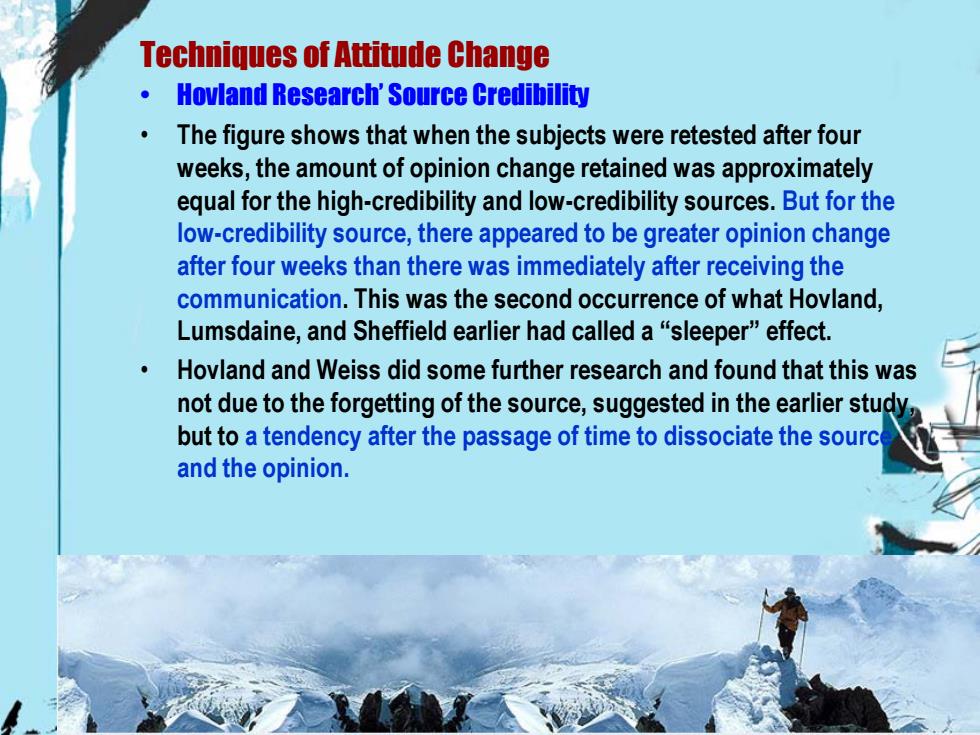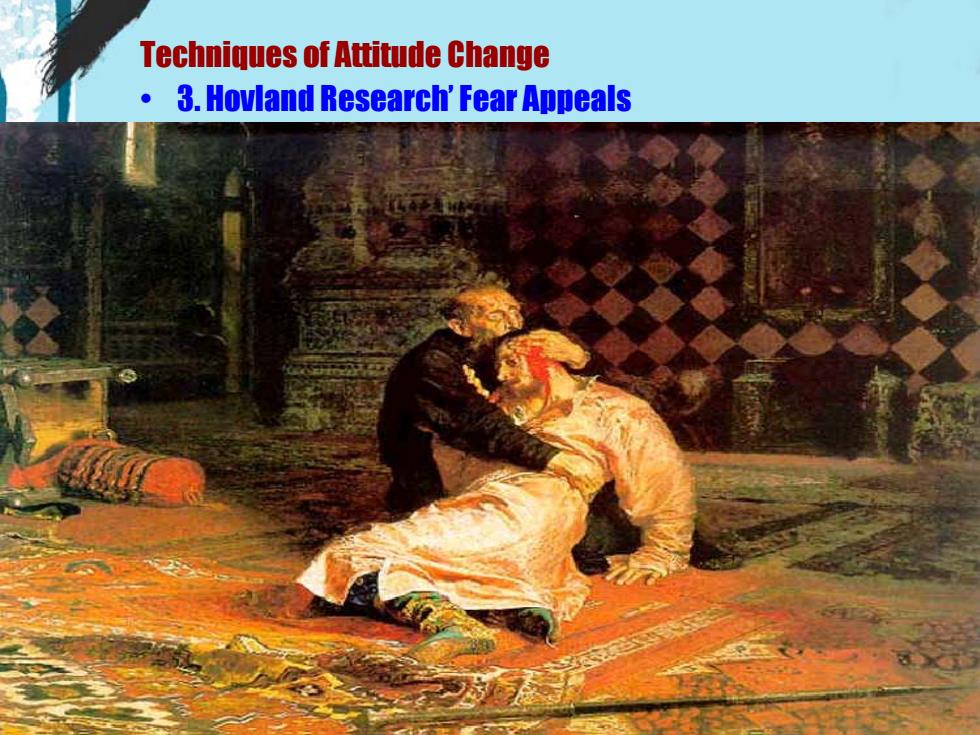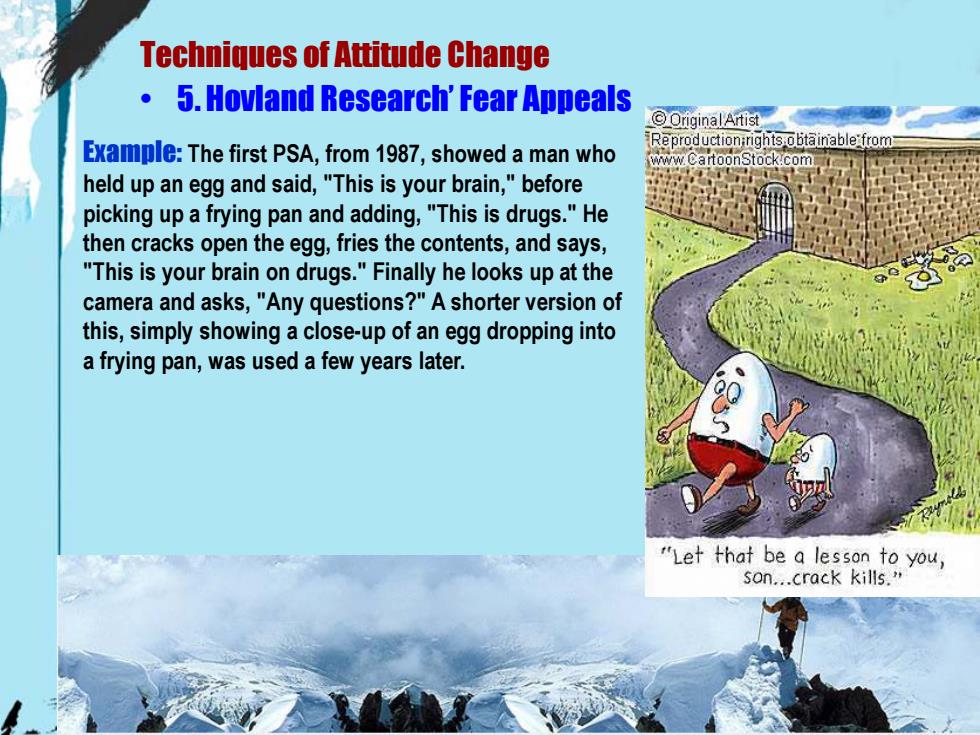
Techniques of Attitude Change Hovland Research'Source Credibility The figure shows that when the subjects were retested after four weeks,the amount of opinion change retained was approximately equal for the high-credibility and low-credibility sources.But for the low-credibility source,there appeared to be greater opinion change after four weeks than there was immediately after receiving the communication.This was the second occurrence of what Hovland, Lumsdaine,and Sheffield earlier had called a"sleeper"effect. Hovland and Weiss did some further research and found that this was not due to the forgetting of the source,suggested in the earlier study but to a tendency after the passage of time to dissociate the sourc and the opinion
Techniques of Attitude Change • Hovland Research’ Source Credibility • The figure shows that when the subjects were retested after four weeks, the amount of opinion change retained was approximately equal for the high-credibility and low-credibility sources. But for the low-credibility source, there appeared to be greater opinion change after four weeks than there was immediately after receiving the communication. This was the second occurrence of what Hovland, Lumsdaine, and Sheffield earlier had called a “sleeper” effect. • Hovland and Weiss did some further research and found that this was not due to the forgetting of the source, suggested in the earlier study, but to a tendency after the passage of time to dissociate the source and the opinion

Techniques of Attitude Change 3.Hovland Research'Fear Appeals
Techniques of Attitude Change • 3. Hovland Research’ Fear Appeals

Techniques of Attitude Change 。 5.Hovland Research'Fear Appeals Fear appeals are persuasive messages designed to scare or frighten people into complying with a particular message by describing the awful and terrible things that will happen to them if they do not act in accordance with the message(Witte, 1992).Fear itself can best be understood as a negatively-valenced emotion accompanied by a high level of arousal that is perceived to be both significant and personally relevant and that motivates people into action(Easterlinger Leventhal,1989;Frijda,1986;Ortony Turner, 1990;Wite,1992;Witte,1998):
Techniques of Attitude Change • 5. Hovland Research’ Fear Appeals Fear appeals are persuasive messages designed to scare or frighten people into complying with a particular message by describing the awful and terrible things that will happen to them if they do not act in accordance with the message (Witte, 1992). Fear itself can best be understood as a negatively-valenced emotion accompanied by a high level of arousal that is perceived to be both significant and personally relevant and that motivates people into action (Easterlinger & Leventhal, 1989; Frijda, 1986; Ortony & Turner, 1990; Witte, 1992; Witte, 1998)

Techniques of Attitude Change 5.Hovland Research'Fear Appeals ©Driginal Artist Example:The first PSA,from 1987,showed a man who Reproduction rights obtainable from www CartoonStock.com held up an egg and said,"This is your brain,"before picking up a frying pan and adding,"This is drugs."He then cracks open the egg,fries the contents,and says, "This is your brain on drugs."Finally he looks up at the camera and asks,"Any questions?"A shorter version of this,simply showing a close-up of an egg dropping into a frying pan,was used a few years later. "Let that be a lesson to you, son..crack kills
Techniques of Attitude Change • 5. Hovland Research’ Fear Appeals Example: The first PSA, from 1987, showed a man who held up an egg and said, "This is your brain," before picking up a frying pan and adding, "This is drugs." He then cracks open the egg, fries the contents, and says, "This is your brain on drugs." Finally he looks up at the camera and asks, "Any questions?" A shorter version of this, simply showing a close-up of an egg dropping into a frying pan, was used a few years later

Techniques of Attitude Change 。 3.Hovland Research'Fear Appeals First Example:Tooth Decay By Janis and Feshbach. First Times:Limited Effect [Very Early Decayl IDecayl ISevere Decayl
Techniques of Attitude Change • 3. Hovland Research’ Fear Appeals First Example: Tooth Decay By Janis and Feshbach. First Times: Limited Effect